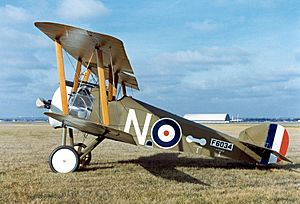George Edwin Thomson facts for kids
Quick facts for kids
George Edwin Thomson
|
|
|---|---|
| Born | 19 September 1897 Rangoon, Burma |
| Died | 23 May 1918 (aged 20) Port Meadow, Oxford, England |
| Buried | |
| Allegiance | |
| Service/ |
British Army |
| Years of service | ca 1916–1918 |
| Rank | Captain |
| Unit | King's Own Scottish Borderers Royal Flying Corps
|
| Awards | Distinguished Service Order Military Cross Distinguished Flying Cross |
Captain George Edwin Thomson was a brave Scottish pilot during World War I. He was known as a "flying ace" because he shot down or helped shoot down 21 enemy aircraft. He was one of the best pilots in his squadron and was famous for flying the Sopwith Camel plane.
Contents
Early Life and Joining the War
George Edwin Thomson was born in Rangoon (now Yangon), Burma (now Myanmar) on September 19, 1897. His parents, James and Ellen Thomson, were from Scotland.
When he was older, George traveled to the United Kingdom to join the British Army. He first joined a group called the King's Own Scottish Borderers. In September 1916, he decided to join the Royal Flying Corps. This was the air force of Britain at the time. By December 1916, he became a Flying Officer.
Becoming a Flying Ace
During his flight training, George had a serious accident. He was hurt and had scars on his face. But this did not stop him from flying! In the summer of 1917, he joined 46 Squadron. Here, he flew a plane called the Sopwith Pup. On September 25, 1917, he got his first victory. He destroyed an enemy reconnaissance plane.
Later, his squadron started using a new plane, the Sopwith Camel. On November 30, 1917, George used his Camel to destroy an Albatros D.V plane. He also captured a Pfalz D.III plane. On December 10, he forced another Albatros D.V down out of control.
George continued to be very successful in March 1918. He used four different Sopwith Camel planes and achieved 15 victories that month! This included four victories on March 16 and three on March 23. His total number of victories reached 21. He destroyed five enemy planes and forced fifteen others down out of control. He even shared some of these victories with other pilots like Sydney Smith and Horace Debenham.
Awards and Recognition
For his bravery and skill, George received several important awards:
- The Military Cross on April 22, 1918. This award is for acts of bravery during battle.
- The Distinguished Service Order on June 22, 1918. This is a very high award for outstanding service in war.
- The Distinguished Flying Cross on September 21, 1918. This award is specifically for bravery while flying.
His Final Flight
After his many victories, Captain Thomson was sent back to England. His new job was to teach other pilots as an instructor. On May 23, 1918, he took off from an airfield near Oxford. Sadly, his plane caught fire, and he died in the crash. He was buried at Wolvercote Cemetery in Oxford.
George Edwin Thomson was a true hero who showed amazing courage and skill as a pilot during World War I.


